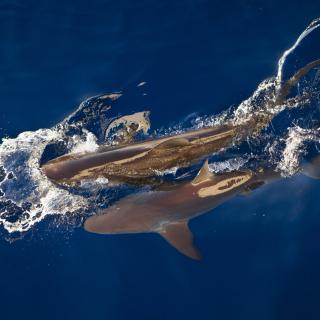Understanding Microplastic Impacts on the Hawaiian Islands

As part of the second expedition of OET's expanded ocean exploration program, From Shore to the Abyss, a team of scientists, conservationists, and educators will conduct a robust microplastic sampling program. Led by Rozalia Project Founder Rachael Miller, the team will create a map of microplastic and anthropogenic microfiber pollution found in the surface waters and air surrounding the Hawaiian Islands of Maui, Lana'i, and Hawai'i Island. This research will contribute as yet undocumented and important knowledge to protect these essential waters.
The microplastic team has three goals for this expedition; to conduct a robust microplastic sampling program and map of pollution, engage onboard citizen scientists and deliver inspiring outreach programs for students and people worldwide. This expedition is made possible by a collaborative partnership between OET and National Geographic, resulting in a high-impact expedition that advances our discovery of multiple disciplines of oceanography, marine ecology, and conservation.
Microplastic sampling will come from three different environments using various methods. The team will use buckets and jars to collect samples from the ocean's surface, a pump-based air sampler used in the air, and deposition buckets to collect samples that fall from the sky. All samples will be processed and examined using a stereomicroscope and polarizing light microscope to count and characterize the microplastics and anthropogenic microfibers found in the samples. Morphological details will be recorded, and all data will be mapped and made available for collaborators.
These methods were developed in collaboration with Prof. Claire Gwinnett, an award-winning forensic fiber scientist from Staffordshire University in the UK and a member of the expedition team. They are designed to lower costs while increasing accessibility. Onboard citizen scientists will have the opportunity to support and collaborate on all parts of sampling and demonstrate the accessibility of the method as one that can be utilized by a wide variety of scientists and conservationists, not just those in academia, as part of a program called, CSI for the Ocean.
The Hawaiian Islands themselves are a known "marine macrodebris sink." The presence of macroplastic and derelict fishing gear on the beaches of both populated and remote islands is well known - we have all seen photos of dead albatross with stomachs full of weathered, plastic consumer debris. Unlike stationary marine life territorial to specific habitats within the PMNM, marine debris, microplastics, and anthropogenic microfibers move about Hawaiian waters assisted by currents and weather conditions.
While many studies have revealed the toxicity of plastic to a myriad of species found on or near the Hawaiian Islands, there is insufficient data on the type, distribution, and concentration of those microplastics. By expanding our knowledge of microplastics in the air and water of the archipelago, we can better understand and mitigate this threat.
Should we discover new information about microplastic pollution (including a possible link to macroplastics), our study method would be an inexpensive and accessible way for any vessel to identify marine debris hot spots quickly. This research could potentially leave a legacy of knowledge and action for those charged with protecting Hawaii's waters and for our collective ability to understand MPs through citizen science worldwide and compare those findings.
Launching in 2022, the From Shore to the Abyss Program expands OET’s ocean exploration program from the deep sea into coastal coral ecosystems lending our ship and research experience to contribute to new discoveries focused on the conservation of reefs and the generation of new knowledge. The program in 2022 will focus on the main Hawaiian Islands hosting a variety of teams leading research projects to gain a better understanding of the resident sharks and marine mammals, the impact of plastics on marine environments, and the maritime history of Hawai’i. This expedition is funded by the National Geographic Society.

From Shore To the Abyss: Exploration of Shark Communities and Microplastic Pollution in the Main Hawaiian Islands
In our second leg of the From Shore to the Abyss program, OET and National Geographic Society are exploring the waters of Maui and Hawaiʻi island while studying sharks and microplastic pollution investigating the intersection of humans and the ocean environment to inform policy and management of this ecosystem.

From Shore To the Abyss: Exploration of Maritime Heritage and Microplastic Pollution in the Main Hawaiian Islands
Our third From Shore to the Abyss expedition finds OET and National Geographic Society investigating maritime cultural heritage and plastic pollution in the waters around Lānaʻi and Maui. Both project teams will investigate evidence left behind by humans to better understand what happened in the past, as well as what this means for the future. Projects focus on the intersection of human actions and the ocean environment to inform policy and management of this ecosystem.



